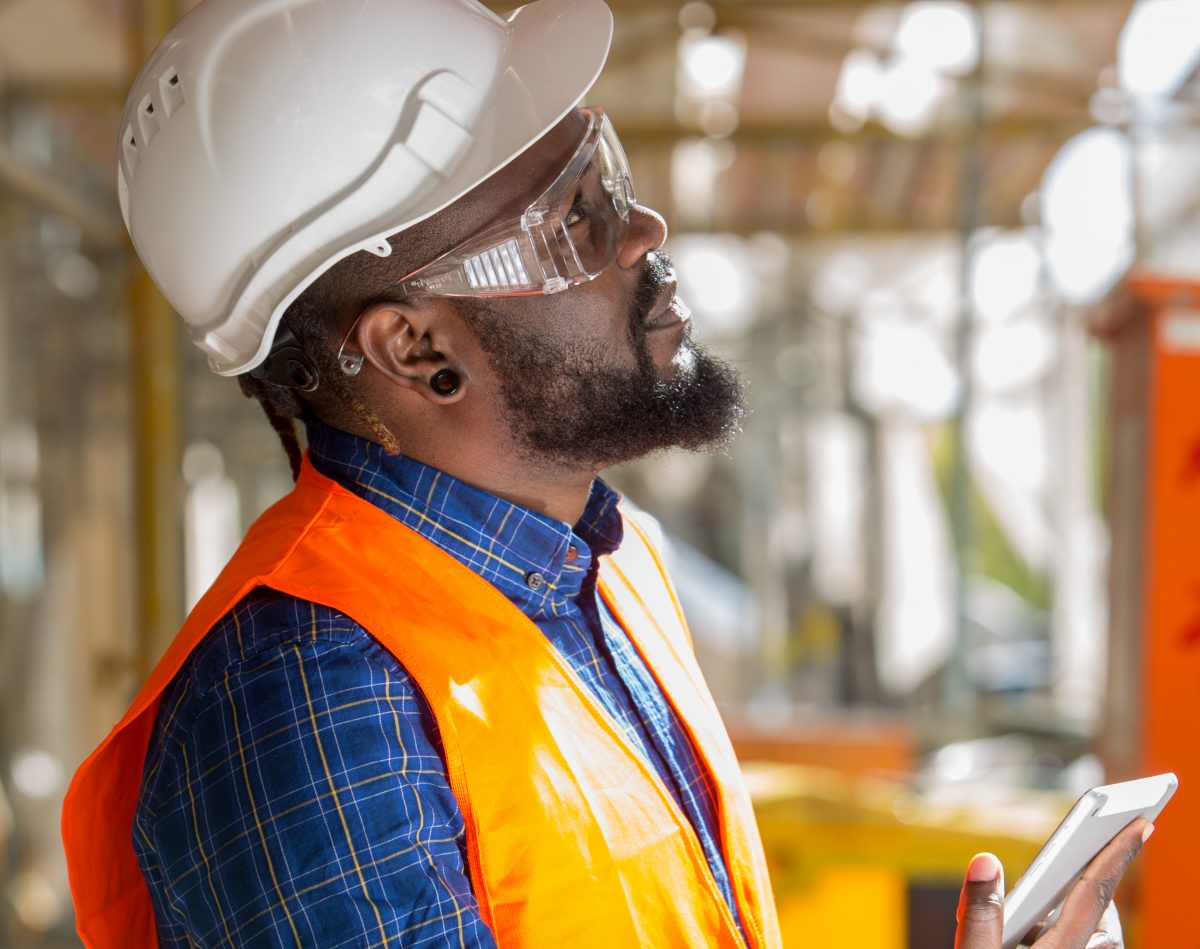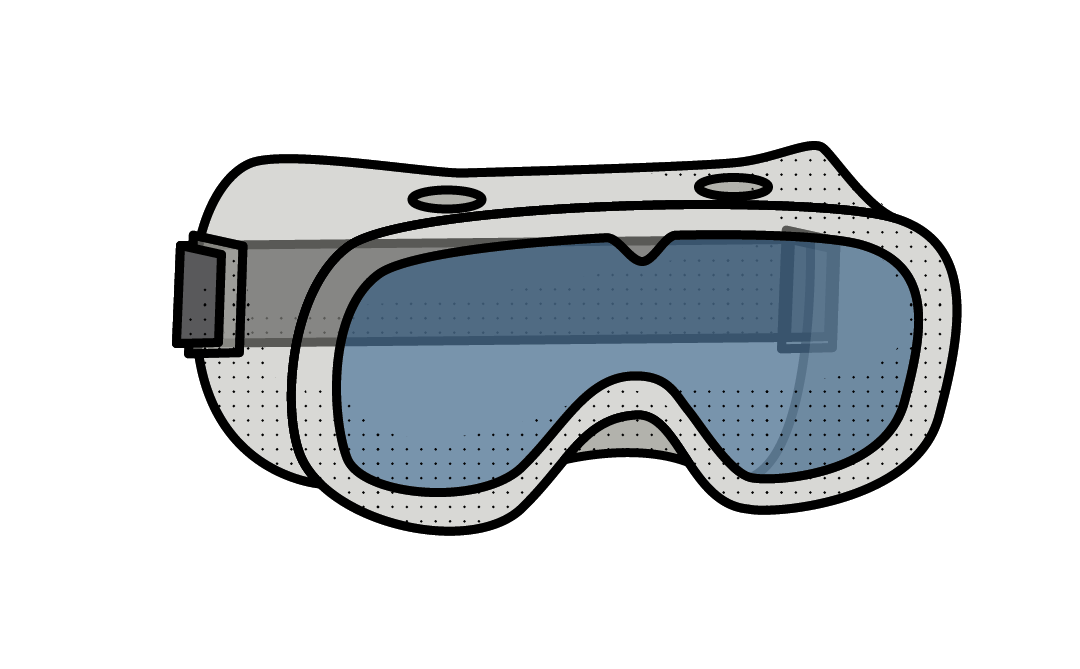If your team is exposed to hazards to their eyes and vision, it’s your job to provide the appropriate eye protection. While OSHA makes that much clear, the agency is less clear on choosing the best, most cost-effective yet practical safety gear as a part of your larger PPE management plan.
We put this guide together to help you make confident decisions around eye protection. At the end, you’ll have a plan for evaluating the types, models, features, and vendor solutions you need.
Background: the Job Hazard Analysis
Choosing the right eye protection is like choosing the right tools. It’s common to hear “select the right tools for the right job.” Since the right eye protection depends on the job, a thorough analysis of the job requirements and hazards is an essential step when choosing the right PPE for your employees.
In industry and construction, the term for this is either “Job Hazard Analysis (JHA) or Job Safety Analysis (JSA).” They are mostly synonymous with each other. The important part is that they facilitate the assessment of the job, its steps, and the requirements to do it safely.
An Example JHA
Let’s start with a job requiring the use of a cutting torch. Below is a list of considerations when performing a JHA to identify risks to the eyes.
Are there regulations governing the use of a cutting torch in the work I’m doing?
Yes, if doing this in industry or construction. The Occupational Safety and Health Administration (OSHA) is a primary governing body for this type of work
What am I going to be cutting?
Carbon Steel
Where am I going to be doing this work?
A workshop made for this type of work.
What are the hazards associated with doing this work?
- Extreme light
- Fire
- Molten metal
- Metal fumes
How will I control the work hazards?
- The workshop will be kept clean, ventilated, and fire safe.
- Proper, compliant personal protective equipment (PPE) will be worn.
- Regulatory requirements of welding, cutting, and brazing will be followed.
While not exhaustive, the above information is the meat and potatoes of performing a JHA. It doesn’t have to be any more complicated than what is needed to identify, evaluate, and control the hazards of the work.

Where PPE comes into play is in the PPE hazard assessment. It is complementary to a JHA and is required for work covered under OSHA’s general requirements for PPE, 29 CFR 1910.132(d).
A PPE hazard assessment is essentially a JHA with a focus on the protective equipment needed to safely perform the work.
PPE Hazard Assessment for Eye Protection
If you don’t thoroughly evaluate all tasks required for the job, you can’t select the right eye protection. Using the example from the previous section, if you chose to use “general purpose” safety glasses, such as those shown in the photo below, there would be many problems with that. However, if you’re only doing general-purpose manufacturing or construction work, they may be just what you need.
Such glasses are made to meet the ANSI Z87.1 or a similar accepted standard. The OSHA general industry standard 29 CFR 1910.133(b) lists the full range of accepted standards for compliant eye and face protection.
General Purpose Safety Glasses | Welding Face Shield |
In the case of performing welding, your PPE assessment will reveal hazards like metal sparks, splatter, and intense light. Your welders will need adequate eye and face protection in the form of welding face shields. The eyes are protected by a shaded lens that blocks light and splatter, while the face has a sturdy shield.
Don’t fret if you have never performed a formalized, documented PPE hazard assessment. OSHA has provided a detailed, non-mandatory appendix to help perform a PPE hazard assessment in line with their standards.
While helpful, the appendix can be a bit daunting. Here are the general steps of performing an assessment, focusing on eye protection:
What is the job task?
Mixing chemicals in a laboratory
What are the hazards to the eye?
Chemical splash hazards
What types of eye protection can sufficiently protect against the identified hazards?
- Chemical splash rated goggles
- Chemical face shield
What standards does the PPE need to meet to ensure compliance and proper function?
- ANSI Z87.1 (pick one of the specific standards allowed by OSHA)
- The PPE should also be rated for chemical splashes
- Note: A face shield should not be substituted for rated chemical splash safety goggles.
The photo below shows an example of goggles that should be appropriate for the task.
 Splash Resistant Safety Goggles |
It’s important to note that one type of eye protection may provide protection from a wide variety of hazards. You may be able to order one model and instruct an employee to use it for all applicable tasks. Just remember you’ll want each employee to have the most practical form of protection for any given task.
While a given model of splash-resistant goggles may also cover general impact needs, they may be too foggy or cumbersome for non-chemical-related tasks. The same employee likely needs a pair of general-purpose safety glasses as well.
Selecting the Right Eye Protection Features
After your PPE hazard assessment reveals the type of eye protection needed for various tasks, you’re still left to make decisions surrounding design style, brand, and features. This is important because the point of any PPE is to protect. But it can’t work if workers won’t wear it or it gets in the way. Here are some considerations when dialing in on eye protection specifics:
- Eye protection can fog up when paired with respiratory protection or temperature changes. With the new COVID-19 protection guidelines requiring face masks, you may find it easier to choose anti-fog eye protection when buying or replacing eye protection.
- If you want longevity, even if only from the constant putting on and taking off the eye protection, consider scratch resistant versions.
- A comfortable and secure fit helps ensure the PPE is worn consistently.
- Goggles can be worse at fogging up, so vented models may help, so long as they maintain their splash rating.
- It can be bright outside, so outdoor tint can be a game changer.
- For workers that must go in and out a lot, try indoor/outdoor tinted eye protection.
- Some people need to see clearly while indoors. So, no tinting.
- Some people work in very dusty environments and general safety glasses just won’t cut it. Purchase protection rated for dust or fine dust.
- As noted above, eye protection needs to work well with other PPE.
- Some personnel wear prescription glasses. They will need either prescription safety glasses or safety glasses that can fit over their prescription glasses.
As you can see, ordering in bulk may prohibit the type of features customizations truly needed for your team. We’ll discuss more on that below.
How to Manage an Eye Protection Budget and Inventory
There still is at least one more consideration you must make when selecting for features, and that is your budget!
Usually, the more features the eye protection has, the more it will cost. That said, shopping various vendors and quantities may show that the same product can be acquired at a lower price. Shopping for eye protection is like shopping for anything else in that regard.
Each vendor will have pros and cons. A more expensive vendor may have a bigger selection and free shipping. Vending solutions allow you a la carte options and reduce the need for an in-house inventory.
The right choice in eye protection is the one that meets standards, meets your needs, and fits your budget.
It’s worth noting that five cheap pairs of eye protection may not last as long as one expensive, quality piece of eye protection. Consider the long and short terms when making your selections.
Budgeting Decisions: Specs vs. Reality
It goes without saying that the eye protection you provide must meet applicable specifications. Unfortunately, the catalogue specs don’t always match with reality on the floor or in the field.
This isn’t to say that the specs aren’t accurate to the testing standards. However, it is unlikely that they 100% represent your unique situation and work environment. Remember: just because something is rated for a given use doesn’t mean that it’s OSHA-compliant.
So, how can you know for sure that the eye protection will work for you? You can run trial tests with your employees.

Trial tests don’t have to be expensive. Some vendors may offer free samples for certain types of PPE. (They want your business, after all.)
If glasses or goggles meet your needs by the specs, you can then try them out in the field. It’s recommended that you try them out with a variety of employees with a variety of dispositions. For instance, employees that tend to be team players will usually work with you and give you honest feedback. Those that are more critical will be great references if they turn out to like the product.
Getting free samples may take some research and negotiation, but they’re out there.
Running an Eye Protection Field Test
Now for the test itself. Using your free samples or small order, distribute the various types of properly rated PPE to employees to try out in the field.
If you want good, actionable data, follow this a quick guide.
How to set up your field test:
- It’s a good idea to not attempt to try more than 3-5 different brands of PPE at one time.
- Select a reasonable timeframe. Depending on the job, a month is probably a good rule of thumb
- Select your desired outcome. Which one meets your desired outcome the closest?
- Be realistic with your desired outcome.
How to select a representative sample of personnel and jobs to try out the PPE:
- Make sure that if you’re comparing eye protection brands that you compare apples to apples.
- They’ll need to be subjected to similar conditions for an accurate comparison.
How to document the test and communicate instructions:
- Document your field tests so you can make objective decisions.
- Keep a log of what trial eye protection was issued to which person. Include the issue date.
- Include instructions to not discard the eye protection if they think they can’t use it anymore. You want to know the potential life expectancy of the PPE for the given job.
How to draw conclusions:
- Plan and document intervals where you will follow up with the personnel trying out the eye protection.
- Note if employees properly use and maintain the PPE. It’s a very good sign if they do this without prompting from you!
- Get participant feedback.
- Inspect the ongoing condition of the PPE yourself and document your observations.
When the trial is over, you should have excellent data regarding ease of use, practicality, fit, and (to a limited extent) durability and effectiveness in the face of different hazard levels.
The data you have collected will also help you determine how well your employees take ownership of their eye protection. At the end of the day, you’re selecting for safe employee behavior just as much as ratings specs.
Stocking and Inventory
Once you’ve selected the brand and models you need, consider how best to stock, distribute, and manage eye protection. Check out this general guide for inventory management for any type of PPE.
Your system can be as simple as having a place for easy access if the protection is inexpensive. You or support staff can track inventory with a simple paper or digital signout sheet and order more as supplies get low.
A vending machine is a similarly convenient solution for employees and eliminates the need for inventory management.
If your eye PPE pricey, you won’t want employees to go through it too quickly. You may be surprised at how often people can simply trash an otherwise good pair of PPE just because it is a little dirty.
Losing PPE is also common, so you’ll want to promote and even incentivize proper care and maintenance.
Finally, don’t forget to distribute proper eye protection to leadership. When everyone—including the people “at the top”— follows your rules regarding eye protection, it boosts your overall safety culture.
The Last Steps
At the end of the day, you’ll need to pull the trigger and make a choice. Don’t sweat it. Eye protection selection is a continual improvement process, just like any other safety action.
It took an assessment to get down to choosing the right eye protection. It will take ongoing assessments to manage it appropriately. Keep things as simple as they practically can be. If you choose PPE that the workers are comfortable with and level with them on why it’s needed, they will typically appreciate that. This makes eye protection management much easier.
After all, it’s easy to communicate why we should protect our eyes: “Humpty Dumpty couldn’t be put back together. Do you really want to take that chance with one of the most delicate, complicated parts of your body? I wouldn’t.”
